Contents
of the Spring 2008 Northants News
|
Split rocks
and broken credit cards
Seeking Ariocarpus
fissuratus in flower
Richard Booth |
Richard from Wales contributes
his account of a cactus hunting trip to the Big Bend area of Texas, October 2007
You can click
many of the images for a better one and more information.
|
Thursday 4th
October
We drove from Alpine to Study
Butte/Terlingua. The countryside was very green compared to our previous visits
in 1988 and 1999. We booked into the Chisos Mining Company Motel in Terlingua;
pretty basic but quite acceptable.
Drove Texas highway 170 (El
Camino del Rio) to Lajitas and wandered around taking pictures – it was very
quiet. There was a nice Ferocactus hamatacanthus in flower in a
decorative container. These Texans have taste!
|
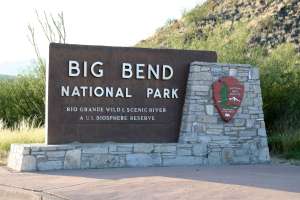
|
|
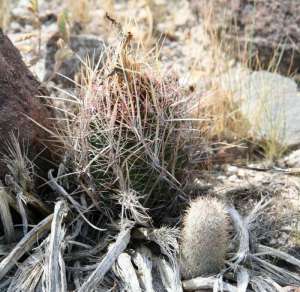
Thelocactus bicolor which
is a rare plant in this area together with a small white spined Escobaria
sneedii var. albocolumnaria |
We drove as far as the Tepee
picnic site for a late lunch. Returning towards Terlingua, we stopped at a known
site for Mammillaria pottsii – a strange white rock formation on the
north side of the road. Scrambling up to the left of this rock, there are
numerous plants together with Echinocereus stramineus, E. enneacanthus
and E. dasyacanthus and an unidentified Mammillaria (or was it an
Escobaria?).
Further down the road there were
more, then a pleasant surprise; Thelocactus bicolor – just one adult.
This was the first time we have found this plant in this area.
Approaching Terlingua ghost town
we stopped at the top of the hill in a huge parking area to photograph the view
of the distant Chisos mountains. The limestone pavement there contained some delightful miniature Mammillaria pottsii, possibly
Escobaria sneedii var. albicolumnaria, Echinomastus warnockii,
Mammillaria lasiacantha and very green Ariocarpus fissuratus. They
were not in flower! We ate dinner at La Kiva – half underground and very dark.
A strange place but the food was OK. There were lots of locals propping up the
bar.
In town, we found lots of nice Echinocactus
horizonthalonius on the left hand side of road to the new school about
halfway down.
|
Friday 5th
October
We planned to drive to
Presidio and maybe beyond. Between the motel and Terlingua Creek we
spotted a desert tarantula crossing the road and stopped to take
photos and video.
We stopped at the top of
the hill again and looked on the opposite side of the road. The same
plants were present but we found a lovely clump of Escobaria sneedii
var. albicolumnaria.
At the site we found Thelocactus
bicolor, we looked again and found two more, one adult under a bush
and a juvenile in full sun. We GPSed the site for Trev who had asked us to
look out for these. (Trev – thanks Richard)
We drove on to Presidio and
returned to Terlingua. That evening we ate dinner at the Starlight Theatre
in the ghost town; the food was superb and the staff friendly.
Saturday
6th October
The plan was to drive to
Santa Elena Canyon. On the way, we stopped and walked to the Burro Mesa
Pour Off. We also had a good look at Tuff Canyon – there were some nice
clumps of E. dasyacanthus with wide colour variation of the spines.
We stopped again at the
huge clump of Blind Prickly Pear (Opuntia rufida) at a favourite
stopping place. An image from our 1988 trip hangs on our sitting room
wall. There were huge clumps of Echinocereus enneacanthus and Coryphantha
macromeris along the road from Castolon to Santa Elena Canyon
Overlook. Also a big C. macromeris on the side of the road into the
Castolon historic area.
We ate dinner at the
Starlight Theatre again – excellent! The waiter managed to snap my Visa
card in two!!!!
|
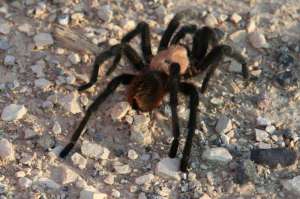
Above: A desert
tarantula crosses the road.
Below: Classic
Texas history - The Starlight Theatre.
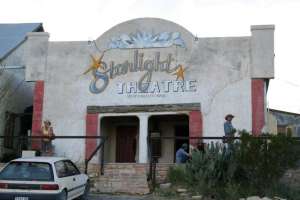
|
|
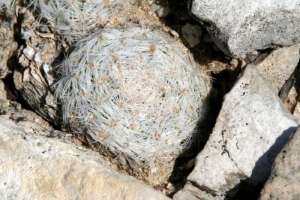
Above: The lace-spine cactus Mammillaria
lasiacantha. |
Sunday 7th
October
Our plan was to drive to
Boquillas Canyon, stopping as desired.
Our first stop was a
limestone ridge, a well trodden area but still full of plants. We spotted Escobaria
tuberculosa, Echinocactus horizonthalonius, Echinocereus
dasyacanthus, Echinomastus warnockii, Coryphantha nicholli,
Mammillaria lasiacantha, (left), Ariocarpus fissuratus and Epithelantha
bokei (below). The best plants here were an eight headed Mammillaria
lasiacantha and a four headed Epithelantha bokei.
We spotted a Ferocactus
hamatacanthus with a dead flower on the cliff where the Boquillas road
winds through a canyon and had to stop to photograph it. Then we spotted a
couple more and photographed them; the nicest plant had a dead flower plus
an almost mature fruit. We also photographed Echinocactus
horizonthalonius, Opuntia rufida with red brown glochids and
another nice prickly pear. |
|
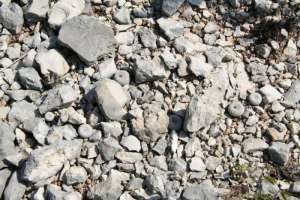
|
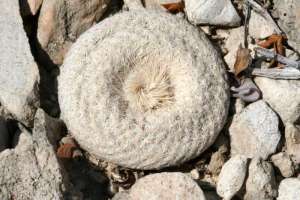
|
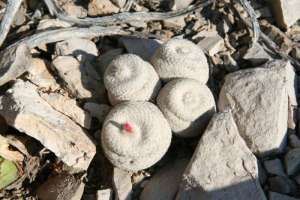
|
| Habitat
and plants of Epithelantha bokei. A ‘button cactus’. The
four-header might just be four seedlings as the plant is normally
solitary. |
It was very hot (low 90s)
at Boquillas Canyon so we decided not to walk into the canyon. Instead, we
strolled about above the car park and looked at cacti – Echinomastus
warnockii, Echinocactus horizonthalonius and Echinocereus
dasyacanthus.
We called in at the visitor
centre on the way back and met a ranger (who was an expert on the cacti of
Big Bend) and discussed where to find the elusive Ariocarpus fissuratus
in flower. She said she had seen some in flower on the Terlingua –
Lajitas road a couple of days previously – how did we miss them? We went
to the place and found plants with dead flowers (the first in this
condition). The ranger also introduced us to Powell and Weedin’s book
‘Cacti of the Trans-Pecos and Adjacent Areas’. (Ed:
I have reviewed this book in this edition.)
We drove up to the Chisos
Basin and checked in at the Lodge. Eating at the Chisos Lodge restaurant,
we found it very much improved from our last visit and not overly
expensive.
We decided to attend the
ranger presentation in the Basin amphitheatre on “Cacti of Big Bend”.
We expected to be bored but the speaker was the ranger we had talked with
and she gave an excellent presentation. Afterwards, we spoke with her in
detail about our plans for the remaining two days. Because of the heat, we
didn’t fancy the two miles each way hike to the colony of Echinomastus
mariposensis that we knew about. She suggested an alternative, which
involved only 200 yards of hiking. She also gave us a location for Echinocereus
chisoensis, which we had not seen before.
|
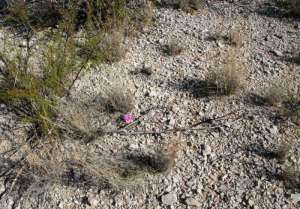
|
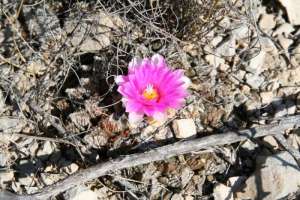
|
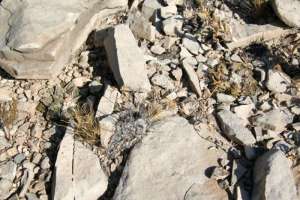
|
|
Ariocarpus
fissuratus, the 'split rock' cactus which is easy to see in flower
but well camouflaged during the rest of the year. |
Monday 8th
October
We were permitted to visit a
study site for Echinomastus mariposensis. Some of the plants had ‘dog
tag’ markers, others stones turned upside down with a number on them. While
looking for mariposensis, we came across three Ariocarpus fissuratus,
each with a single flower. At last the main objective for our visit had been
achieved! Other plants encountered were Escobaria tuberculosa?, Echinocereus
dasyacanthus, Echinocactus horizonthalonius and the biggest Ariocarpus
fissuratus we have ever seen – well over six inches across and nearly
three inches high as it was growing in a shaded position. It had one recently
closed flower on it.
|
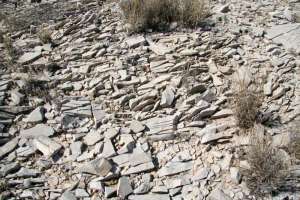
You can
click this image to play 'spot the Ariocarpus' |
We drove towards Persimmon Gap
and stopped in the pull-off for the Dog Canyon Trail. We walked along the trail
for about 100 yards and started to find ‘horse cripplers’ (Echinocactus
texensis) which is a rare plant in the Park and Coryphantha macromeris.
We had seen these plants in flower in 1999 and they were quite healthy, though
shrunken then. In 2007, they were a sorry sight – most of the big plants were
reduced to a pile of spines and there was no sign of regeneration.
We gave up looking for them and
tried the limestone hill immediately to the north of the sand flats. Here we
found: Mammillaria heyderi?, Ariocarpus fissuratus (lots of small
plants here), Mammillaria lasiacantha, Echinocactus horizonthalonius,
Glandulicactus uncinatus var. wrightii and Coryphantha
macromeris(?).
|
|
Tuesday 9th
October
We headed straight to the site of
Echinocereus chisoensis we had been given and started to find plants
immediately – but they were large clumps of Coryphantha echinus var. robusta.
Then we spotted our first chisoensis, a small, solitary stem under a
creosote bush within 50 yards of the vehicle. Soon we were finding lots of them,
single and multi-stemmed, all growing under creosote and often with Dog Cholla.
We didn’t go more than 100 yards from the vehicle but the site is quite
compact. Other plants in this area were Echinocactus horizonthalonius, Coryphantha
macromeris and Echinocereus dasyacanthus.
We continued and turned down
River Road East to explore some limestone hills. We found: Escobaria
tuberculosa, Echinocactus horizonthalonius (lots of little ones), Echinomastus
warnockii, Ariocarpus fissuratus (not flowered), Echinocereus
stramineus, Coryphantha echinus, Echinocereus dasyacanthus
and, right on top, Ferocactus hamatacanthus, Epithelantha bokei
and Mammillaria lasiacantha.
We drove down to Hot Springs –
and yes, it was very hot. The river was too high to see the spring. We spotted
one Ferocactus hamatacanthus. The one we had seen on the edge of the
cliff in 1999 is still there but looked dead.
Wednesday 10th
October
We left Big Bend and drove
highway 90 to Del Rio. Sanderson is a very run down place indeed so we didn’t
bother to stop. We did pull off the highway to visit the Judge Roy Bean Visitor
Centre at Langtry – a modern visitor centre with the original Jersey Lily
Saloon and Roy Bean’s Opera House preserved behind it. Also the cactus garden
admired by the Lambs in the 70s still exists but is pretty run down; there is a
list of plants which should be there!
We stopped for lunch at the
overlook of the bridge over the River Pecos. Approaching Amistad Lake, we drove
down Spur 406 to the lake. Driving back along this road, we spotted a plant from
the vehicle so stopped to investigate; a solitary plant of Ancistrocactus
brevihamatus.
|
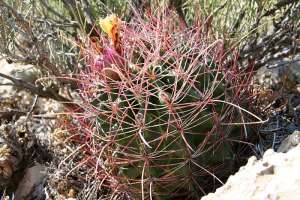
Ferocactus
hamatacanthus with spent flower and mature fruit.
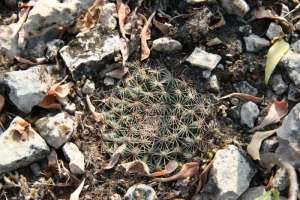
Mammillaria
heyderi often grow in the shade of trees and bushes. When it is dry
they pull themselves into the ground.
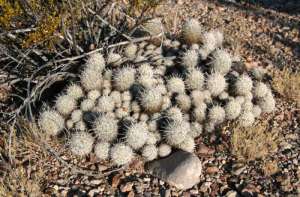
A
cluster of Coryphantha echinus var. robusta
|
|
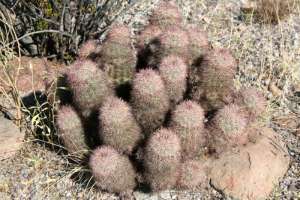
|
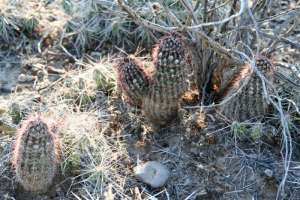
|
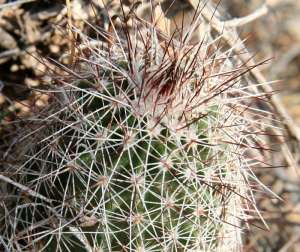
|
| A superb cluster
of Echinocereus
dasyacantha. |
Echinocereus
chisoensis, a rare plant of the Big Bend. Left; Three plants are
in the partial shade of a shrub and guarded by cholla. Right: This
plant is a juvenile but shows the characteristic spination with the two main
centrals brown and around 10 radials. |
Thursday 11th
October
Volunteers in the Visitor Centre
suggested we look around Diablo East. We photographed the two bridges crossing
the lake. In the fairly dense undergrowth around one of the campsites, we found Mammillaria
heyderi and what looked like another tiny Mammillaria but was probably Coryphantha
pottsiana according to Powell & Weedin. The plants had solitary stems
and brown tipped spines. We also saw Mammillaria prolifera, Echinocereus
enneacanthus var. brevispina (according to Powell & Weedin); Ancistrocactus
brevihamatus, and another plant, which may be brevihamatus but looks
different somehow. Then clumps of the tiny Mammillaria? with brown tipped spines
(Coryphantha pottsiana).
Having eaten lunch at the marina,
we crossed highway 90 and took the road to Governor’s Landing. The road goes
under the highway 90 bridge to a parking area and we explored a limestone area.
It looks derelict as a lot of waste concrete has been dumped here but there is
still some original ground left. The first plants we came across are clearly of
the Ferocactus/Hamatocactus type but which species?; they could be
Ferocactus hamatacanthus var. hamatacanthus or var. sinuatus
or Hamatocactus bicolor according to Powell and Weedin’s distribution
maps. They certainly didn’t look like the juvenile Ferocactus hamatacanthus
found in Big Bend. Also here were the tiny Mammillaria? (Coryphantha
pottsiana) with brown tipped spines, Ancistrocactus brevihamatus and
a huge Ferocactus hamatacanthus, which could be var. sinuatus as
the ribs spiral a bit. Then surprise, surprise, loads of Epithelantha
micromeris and lots of tiny ones showing good regeneration; as many as six
in one photograph.
We had to get to a bank before it
closed to cash traveller’s cheques so we had to leave the plants. Having got
the cash we went to Val Verde Winery for a swift tour and tasting and bought a
couple of bottles. Souvenirs of a great trip and we had achieved our ambition to
see Ariocarpus fissuratus in flower. And a lot besides!
Richard
|
Ed: Thanks
Richard. It’s great to hear of your travels. I was discussing Richard’s
article and he mentioned seeing many ‘Eeyores’ at one site. This was a
new one on me. Commonest pet names for cacti in habitat in this area are
‘UFOs’ (Unidentified Fabulous Opuntias, I may
have got this wrong), ‘trigly’ (a plant of the Echinocereus
triglochidiatus/coccineus persuasion) and ‘Ham squared’ (Hamatocactus
hamatacanthus). This last will be a puzzle in the future as the plant
is now generally called a Ferocactus. As to ’Eeyore’; it is not a
donkey but E. hor - izonthalonius, a common plant of the Big Bend.
Should have guessed it really!
|
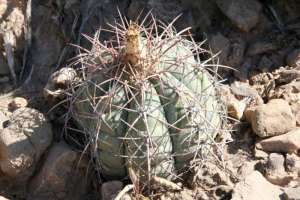
Echinocactus
horizonthalonius, the ‘Turk’s head cactus’, (or 'Eeyore'!) is a
common plant of Big Bend.
|



















